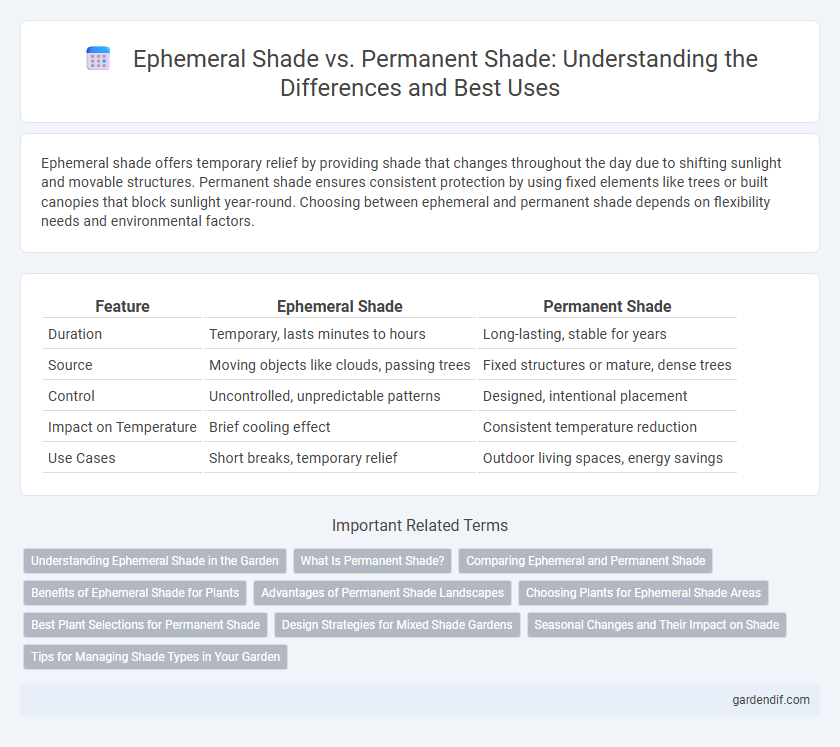
Ephemeral shade vs permanent shade Illustration
Ephemeral shade offers temporary relief by providing shade that changes throughout the day due to shifting sunlight and movable structures. Permanent shade ensures consistent protection by using fixed elements like trees or built canopies that block sunlight year-round. Choosing between ephemeral and permanent shade depends on flexibility needs and environmental factors.
Table of Comparison
| Feature | Ephemeral Shade | Permanent Shade |
|---|---|---|
| Duration | Temporary, lasts minutes to hours | Long-lasting, stable for years |
| Source | Moving objects like clouds, passing trees | Fixed structures or mature, dense trees |
| Control | Uncontrolled, unpredictable patterns | Designed, intentional placement |
| Impact on Temperature | Brief cooling effect | Consistent temperature reduction |
| Use Cases | Short breaks, temporary relief | Outdoor living spaces, energy savings |
Understanding Ephemeral Shade in the Garden
Ephemeral shade occurs when sunlight is temporarily blocked by moving objects such as passing clouds or swaying tree branches, creating fluctuating light conditions in the garden. This dynamic shade influences plant growth by providing intermittent periods of shade and sun, which can benefit shade-tolerant species by preventing overheating and excessive water loss. Gardeners should consider the patterns of ephemeral shade to optimize plant placement and maintain healthy microclimates within their garden ecosystems.
What Is Permanent Shade?
Permanent shade is a consistent, long-lasting form of shade created by fixed structures or dense, mature trees that block sunlight throughout the day. Unlike ephemeral shade, which shifts and disappears as the sun moves, permanent shade provides reliable protection from direct sunlight, reducing temperature and UV exposure in outdoor spaces. This type of shade is ideal for areas requiring continuous cooling and comfort, such as patios, playgrounds, or gardens.
Comparing Ephemeral and Permanent Shade
Ephemeral shade offers temporary relief from sunlight, often created by passing clouds or movable structures like umbrellas, making it ideal for short-term comfort. Permanent shade is provided by fixed elements such as trees, pergolas, or built canopies, offering consistent protection and contributing to long-term cooling and landscape aesthetics. Comparing both, ephemeral shade is flexible and adaptable but lacks durability, whereas permanent shade enhances property value and energy efficiency by reducing heat gain year-round.
Benefits of Ephemeral Shade for Plants
Ephemeral shade provides plants with temporary protection from intense sunlight, reducing heat stress and preventing leaf scorch during peak hours. This dynamic shading allows sufficient sunlight exposure for photosynthesis while mitigating risks of dehydration and wilting. Such adaptive shade patterns enhance plant growth, improve water retention, and promote overall plant health in fluctuating light conditions.
Advantages of Permanent Shade Landscapes
Permanent shade landscapes provide consistent protection from intense sunlight, reducing heat buildup and lowering cooling costs significantly. These landscapes improve energy efficiency by shading buildings naturally, while also enhancing property aesthetics with mature trees and structures that support diverse ecosystems. Long-term durability and minimal maintenance make permanent shade an environmentally sustainable option that promotes healthier outdoor environments year-round.
Choosing Plants for Ephemeral Shade Areas
Selecting plants for ephemeral shade requires species adaptable to fluctuating light conditions, such as hostas, ferns, and bleeding hearts, which thrive during brief shaded periods. These plants have evolved mechanisms to tolerate both sun exposure and intermittent shade, ensuring healthy growth and bloom cycles. Proper soil moisture management and mulching further support their resilience in transient shade environments.
Best Plant Selections for Permanent Shade
For permanent shade, selecting plants that thrive with limited sunlight is essential, such as hostas, ferns, and astilbes which are well-known for their shade tolerance and low maintenance requirements. Evergreen shrubs like boxwood and holly provide year-round greenery, while shade-loving perennials like heuchera and bleeding hearts add color and texture. These plants ensure a vibrant, healthy garden environment despite continuous shade conditions.
Design Strategies for Mixed Shade Gardens
Ephemeral shade in mixed shade gardens is created by deciduous trees or plants that provide seasonal cover, allowing dynamic light conditions that support a diverse range of understory plants. Permanent shade, produced by evergreen trees or dense canopy structures, requires selecting shade-tolerant species with low light requirements to maintain garden vitality throughout the year. Effective design strategies balance the combination of ephemeral and permanent shade by layering plant heights, incorporating shade gradients, and selecting species that thrive under varying light conditions to optimize biodiversity and aesthetic appeal.
Seasonal Changes and Their Impact on Shade
Ephemeral shade, caused by deciduous trees, fluctuates with seasonal changes, offering cooling relief in summer while allowing sunlight penetration during winter. Permanent shade, typically provided by evergreen trees or structures, maintains consistent shade year-round, influencing microclimates and vegetation growth patterns. Seasonal shifts affect temperature regulation, plant photosynthesis, and soil moisture differently under ephemeral versus permanent shade conditions.
Tips for Managing Shade Types in Your Garden
Ephemeral shade, created by seasonal plants or temporary structures, requires flexible garden planning, emphasizing shade-tolerant annuals and movable pots. Permanent shade, often cast by mature trees or buildings, demands selection of deep-shade perennial plants and soil improvements to enhance root health. Regular monitoring of light patterns and adjusting plant placement optimizes growth and maintains a balanced garden ecosystem.
Ephemeral shade vs permanent shade Infographic

 gardendif.com
gardendif.com